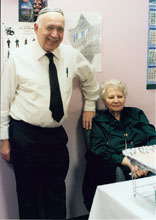News From OSA - January, 2001
 Collective Bargaining. The Municipal Labor Committee completed the Health Benefit Negotiation at an early morning session held on the same day as the PBA rally at City Hall. The meeting was held early to avoid conflict with the rally.
Collective Bargaining. The Municipal Labor Committee completed the Health Benefit Negotiation at an early morning session held on the same day as the PBA rally at City Hall. The meeting was held early to avoid conflict with the rally.
The results of the agreement are a combination of new benefits and give-backs.
The big give-back was one that will affect all future municipal employees – the loss of five year "vesting" for retiree health benefits. At present, every City employee is eligible for both pension pay out and retiree health benefits after only five years of service. However, this is a relatively recent development. Until two years ago, it was ten years of service.
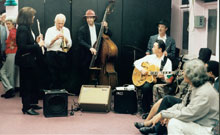 Two years ago the State had agreed to change all of our pension systems to provide for vesting of retirement rights after five years of government service. The Federal retirement law (ERISA) does provide for five year vesting of retirement benefits for the private sector, but such retirement benefits seldom include health benefits for retirees. The City pensions provide excellent retiree health coverage.
Two years ago the State had agreed to change all of our pension systems to provide for vesting of retirement rights after five years of government service. The Federal retirement law (ERISA) does provide for five year vesting of retirement benefits for the private sector, but such retirement benefits seldom include health benefits for retirees. The City pensions provide excellent retiree health coverage.
The city unions were very pleased with the arrival of five year vesting of retirement eligibility, but had mixed feelings about the wisdom of five year vesting for health benefits. When questions were raised by the unions over the prudence of the legislation, the response given was that our local politicians, given a term limit of two terms or eight years, now needed the five year vesting for themselves and the law would include them. We got it because they got it.
given was that our local politicians, given a term limit of two terms or eight years, now needed the five year vesting for themselves and the law would include them. We got it because they got it.
Currently there is roughly one retiree for every two full time active career employees. The cost of health benefits from the City is between $3000 and $6000 depending on health plan and the number of persons covered. Absent a national health plan, and with the rising cost of health care, there is a danger that in years to come our retirees will outnumber our active employees. The City may, in long term, be unable to fully fund adequate health benefits for all of us if there is too high a ratio of retirees to active employees.
In effect, the generosity of the five year health benefits vesting could end up either raising city taxes to unsustainable levels or alternatively, diluting the benefits we will receive in future years. The City's original bargaining position was far more dramatic than what was finally agreed upon, but was based on the City's fears for the future sustainability of the five year health vesting. One problem the unions had was that we more than halfway agreed with the City's fears.
 The agreement just reached will affect only those prospective employees hired after any legislation is passed to delay retiree health benefits vesting to the (prior) ten year point.
The agreement just reached will affect only those prospective employees hired after any legislation is passed to delay retiree health benefits vesting to the (prior) ten year point.
In addition, there were a host of financial give-backs totaling $170 million of combined cash payments or forgiveness of obligation, plus a promise to seek to find $200 million more of relief for the City.
That's what we gave up, and in return we got some things as well.
Benefit Improvements. The following information applies to OSA members but is slightly different for other union members whose unions have a drug plan.
 Collective Bargaining. The Municipal Labor Committee completed the Health Benefit Negotiation at an early morning session held on the same day as the PBA rally at City Hall. The meeting was held early to avoid conflict with the rally.
Collective Bargaining. The Municipal Labor Committee completed the Health Benefit Negotiation at an early morning session held on the same day as the PBA rally at City Hall. The meeting was held early to avoid conflict with the rally.The results of the agreement are a combination of new benefits and give-backs.
The big give-back was one that will affect all future municipal employees – the loss of five year "vesting" for retiree health benefits. At present, every City employee is eligible for both pension pay out and retiree health benefits after only five years of service. However, this is a relatively recent development. Until two years ago, it was ten years of service.
 Two years ago the State had agreed to change all of our pension systems to provide for vesting of retirement rights after five years of government service. The Federal retirement law (ERISA) does provide for five year vesting of retirement benefits for the private sector, but such retirement benefits seldom include health benefits for retirees. The City pensions provide excellent retiree health coverage.
Two years ago the State had agreed to change all of our pension systems to provide for vesting of retirement rights after five years of government service. The Federal retirement law (ERISA) does provide for five year vesting of retirement benefits for the private sector, but such retirement benefits seldom include health benefits for retirees. The City pensions provide excellent retiree health coverage.The city unions were very pleased with the arrival of five year vesting of retirement eligibility, but had mixed feelings about the wisdom of five year vesting for health benefits. When questions were raised by the unions over the prudence of the legislation, the response
 given was that our local politicians, given a term limit of two terms or eight years, now needed the five year vesting for themselves and the law would include them. We got it because they got it.
given was that our local politicians, given a term limit of two terms or eight years, now needed the five year vesting for themselves and the law would include them. We got it because they got it.Currently there is roughly one retiree for every two full time active career employees. The cost of health benefits from the City is between $3000 and $6000 depending on health plan and the number of persons covered. Absent a national health plan, and with the rising cost of health care, there is a danger that in years to come our retirees will outnumber our active employees. The City may, in long term, be unable to fully fund adequate health benefits for all of us if there is too high a ratio of retirees to active employees.
In effect, the generosity of the five year health benefits vesting could end up either raising city taxes to unsustainable levels or alternatively, diluting the benefits we will receive in future years. The City's original bargaining position was far more dramatic than what was finally agreed upon, but was based on the City's fears for the future sustainability of the five year health vesting. One problem the unions had was that we more than halfway agreed with the City's fears.
 The agreement just reached will affect only those prospective employees hired after any legislation is passed to delay retiree health benefits vesting to the (prior) ten year point.
The agreement just reached will affect only those prospective employees hired after any legislation is passed to delay retiree health benefits vesting to the (prior) ten year point.In addition, there were a host of financial give-backs totaling $170 million of combined cash payments or forgiveness of obligation, plus a promise to seek to find $200 million more of relief for the City.
That's what we gave up, and in return we got some things as well.
Benefit Improvements. The following information applies to OSA members but is slightly different for other union members whose unions have a drug plan.
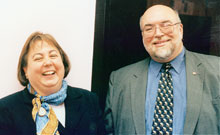 We get $125 added per member to our welfare fund now, and $100 more on July 1st. Unions with drug plans get $175 now and $175 on July 1st.
We get $125 added per member to our welfare fund now, and $100 more on July 1st. Unions with drug plans get $175 now and $175 on July 1st.
- You get – if you are enrolled in a drug rider in your basic health plan – $50 now and $75 as of July 1st. If it were to be simply sent out to you, there might be tax repercussions. Thus the money will probably be used to directly offset the cost of your rider, but hopefully the benefits will be visible and easily verified.
- A total of four categories of drugs will move out of the drug rider and be provided by some other delivery system. This should lower the cost of the drug rider.
As of 7/1/01 (or later since effecting this program will be difficult) your "PICA" drugs will be provided but not be a part of your drug rider.
but not be a part of your drug rider.
Psychotropic Co-payGeneric $0Brand $6Injectables Co-payGeneric $0Brand $6Chemotherapy Co-payNoneAsthma Co-payNone
- Mental Health programs are being improved (more visits, less cost) as well as the rehab programs.
- GHI participating doctors in Manhattan will get a small raise in rates.
- $3 million more is available to expand the GHI network.
- In the future, "line of duty" deaths (not a big problem for Analysts but certainly conceivable) will result in lifetime Welfare Fund coverage for the grieving dependents.
 There will even be a labor/management committee seeking merchant discounts, none of which will we be able to afford unless the Mayor gives us a decent increase in salary as well.
There will even be a labor/management committee seeking merchant discounts, none of which will we be able to afford unless the Mayor gives us a decent increase in salary as well.
- There will also be a 401K plan for all of us.
- Transit check coverage is to be expanded
- There will be a payroll deduction plan for college savings.
Bottom line, the Municipal Labor Committee carried out its proper function under law and worked out an agreement on health benefits acceptable to all save the PBA. The PBA position, as discussed in earlier mailings, was not acceptable to the rest of us.
 Randi Weingarten, as the MLC Chairperson, did very well. She was responsive to the small unions as well as the very large. She was able to overcome many distractions to achieve consensus. This is very good for city labor since the absence of a strong leader would have cost us heavily.
Randi Weingarten, as the MLC Chairperson, did very well. She was responsive to the small unions as well as the very large. She was able to overcome many distractions to achieve consensus. This is very good for city labor since the absence of a strong leader would have cost us heavily.
Promises Kept. The Administrative Analysts employed by the City of New York have been considered to be managers since the creation of the title. They even have pay levels termed "Managerial Pay Level" I, II, III, all the way up to X.
 They are called managers. But many of them are not treated as managers, nor paid as managers. Sometimes, they are treated worse than dirt. They are ordered to work unpaid overtime, passed over when merit raises arrive, given a worse deal on terminal sick leave than their subordinates, and generally exploited.
They are called managers. But many of them are not treated as managers, nor paid as managers. Sometimes, they are treated worse than dirt. They are ordered to work unpaid overtime, passed over when merit raises arrive, given a worse deal on terminal sick leave than their subordinates, and generally exploited.
A large part of this story came out in the seven years of off-again/on-again hearings held as part of OSA's collective bargaining case seeking to represent the Administrative Analysts.
We started our efforts in 1994 because so many of our former members had advanced, by exam, to Administrative Staff Analyst and were calling to ask to be returned to the Associate title. It turned out that if you became an "M" because you were liked by the big boss or were in the "in crowd," you got a nice deal. If you were just hired from a list to do a job, you were often sorry to have advanced. A two percent salary advancement increase did not make up for the loss of grievance rights and frequent overwork, if not outright scapegoating.
The City became very angry during the hearings, as many Administrative Analysts, up to level M III, described under oath how little their job fit the legal definition of manager. OSA's response to the angry City representatives was to note that loyalty was a two way street and exploiting a worker unable to defend himself or herself was not going to earn any loyalty.
 Many years ago there were less managers about, but those few were actually bosses. In 1965, Mary Ellen Gilmore directed Tremont Welfare Center, covering a quarter of the Bronx. Mary Ellen supervised a small number of Sup III's, a dozen or so Sup II's, a few score Sup I's, and a few hundred Caseworkers, plus a large clerical staff and a number of Welfare Police. Mary Ellen seemed very much like a manager, and was paid fairly well to boot.
Many years ago there were less managers about, but those few were actually bosses. In 1965, Mary Ellen Gilmore directed Tremont Welfare Center, covering a quarter of the Bronx. Mary Ellen supervised a small number of Sup III's, a dozen or so Sup II's, a few score Sup I's, and a few hundred Caseworkers, plus a large clerical staff and a number of Welfare Police. Mary Ellen seemed very much like a manager, and was paid fairly well to boot.
In those days a caseworker would start at $5,150 and get a $300 raise each year for the first five years, and another increase each fifth year thereafter. All of this was in addition to contract raises.
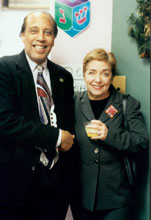 A senior Caseworker – and there was one there who had started work on the day the Department was created in the 1930's – would make more than a very junior Sup I. At the same time, each grade up paid about 10% more than the minimum of the prior title. If this were true today, a $50,000 (no longevity) Associate Staff Analyst should promote to at least $55,000 on going up to MI. The City now offers 2% on promotion and, worse yet, hires "M's" from the street at more than ten thousand dollars less.
A senior Caseworker – and there was one there who had started work on the day the Department was created in the 1930's – would make more than a very junior Sup I. At the same time, each grade up paid about 10% more than the minimum of the prior title. If this were true today, a $50,000 (no longevity) Associate Staff Analyst should promote to at least $55,000 on going up to MI. The City now offers 2% on promotion and, worse yet, hires "M's" from the street at more than ten thousand dollars less.
One more reason. OSA is the child of OSART. Before we had a single unionized Analyst, members paid dues seeking to become union members. First, we won the fight for 38 Analysts at the Board of Education, then 650 more with the City, eventually all Staff Analysts and Associates at the City, OCB and NYCHA, and later Analysts in the Hospitals and Transit Authority.
 OSART was created to be the organization to represent those Analysts not yet represented for collective bargaining. As OSA succeeded, OSART shrunk. The last remaining large group of OSART members are the Administrative Analysts. They have been sending in their dues for, in some cases, over twenty years and only now can we keep our promise to those loyal stalwarts.
OSART was created to be the organization to represent those Analysts not yet represented for collective bargaining. As OSA succeeded, OSART shrunk. The last remaining large group of OSART members are the Administrative Analysts. They have been sending in their dues for, in some cases, over twenty years and only now can we keep our promise to those loyal stalwarts.
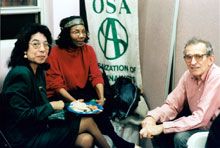 Our attorney, Joan Kiok, persevered in this case for the full seven years – and now the City has offered a settlement.
Our attorney, Joan Kiok, persevered in this case for the full seven years – and now the City has offered a settlement.
If we drop our demands for MIIs, and MIIIs and allow the City to keep control of a few of the MIs who might actually even be really managerial in function, we will be able to add the rest of the MIs to the ranks of represented Analysts.
 The deal is not a final settlement. We will return to the issue three years hence. We fully expect to pick up the right to represent all Administrative Analysts levels MI, II and III unless the City starts to do right by its "managers."
The deal is not a final settlement. We will return to the issue three years hence. We fully expect to pick up the right to represent all Administrative Analysts levels MI, II and III unless the City starts to do right by its "managers."
In the meanwhile, over the next two months OSA will be getting current address lists and sending out mail to our newest members. All of the new members are very welcome but especially those who stayed with OSART over many years.
 The Associate Staff Analyst Exam should be opening filing next month. With luck, OSA will receive the Notice of Examination early and will send out copies of the NOE, plus application forms to all members of OSA/OSART. The good news, thus far, is that OSA's lobbying had effect and there will be only one exam (and one fee) this year.
The Associate Staff Analyst Exam should be opening filing next month. With luck, OSA will receive the Notice of Examination early and will send out copies of the NOE, plus application forms to all members of OSA/OSART. The good news, thus far, is that OSA's lobbying had effect and there will be only one exam (and one fee) this year.
In 1995, most members paid three separate fees for their exams and yet, as OSA pointed out, members were promoted, finally, with little regard for any specific lists. In fact a Staff Analyst working on a budget function could be promoted to Associate using the Personnel Analyst list. The Union favored the practice, but objected to paying the three fees for the one result.
All Staff Analysts, even if appointed for only one day, can file for the exam. That means you can apply for the ASA promotional exam even if you have not yet completed your probation.
 Also, those appointed to Staff Analyst between the filing in February and the exam in June will be allowed to file for the ASA promotional exam through special re-opener procedures through your appointment agency.
Also, those appointed to Staff Analyst between the filing in February and the exam in June will be allowed to file for the ASA promotional exam through special re-opener procedures through your appointment agency.
The training course will be developed after the NOE is issued. It will be based on the type of test announced and content to be tested. Then comes the training (generally extensive) and if we are on schedule, the exam this June.
 Our training course is free to OSA and OSART members and in the past more than one Commissioner has joined OSART just to take our course.
Our training course is free to OSA and OSART members and in the past more than one Commissioner has joined OSART just to take our course.
Clear Vision. Our Welfare Fund will be switching optical vendors this Spring. Any changes make the Fund Trustees nervous since. . . you never know. Meanwhile, a company called National Vision Administrators will become our optical vendor. NVA has more panel participants than does the Davis Vision firm and that is good.
 Our overall costs should remain almost the same (a bit lower in the administrative fees, but a bit higher in processing costs) but at least one novelty comes with NVA. The company will be sending out cards to each member similar to ATM cards but with the OSA symbol on the card. You will be able to use the card to obtain your yearly pair of glasses.
Our overall costs should remain almost the same (a bit lower in the administrative fees, but a bit higher in processing costs) but at least one novelty comes with NVA. The company will be sending out cards to each member similar to ATM cards but with the OSA symbol on the card. You will be able to use the card to obtain your yearly pair of glasses.
Elections. Only one candidate was nominated for an at-large position, John Albanese of the Department of Design and Construction. John thereafter declined the nomination, but did accept appointment as a Chairperson of our DDC chapter. In his new role, he should be scheduling a location meeting sometime this Spring.
Chapters. OSA covers a huge number of employers. One of our best ways to do it effectively is to find on-location activists for every Agency or major sector. This Spring our organizing team will be focusing on the Agency Chapters. Meetings will be set up on location, at lunch time etc. If you wish to be active on your location, call Joe Sperling or Ida Chin at the union office.
 Please note, on-location activists are expected to attend most OSA general membership meetings, read all the union mail and call the Union newsline or visit the newsline page of the website weekly. Otherwise, at the location, members will not have available all the answers on current topics.
Please note, on-location activists are expected to attend most OSA general membership meetings, read all the union mail and call the Union newsline or visit the newsline page of the website weekly. Otherwise, at the location, members will not have available all the answers on current topics.
Transit Authority. A meeting has been scheduled with TA activists to discuss recent develop-ments as they affect bargaining in Transit. Our brothers and sisters at TA are still without a contract, longevity or grievance rights. This is not yet our longest negotiation, but it is a long one.
 OSA Membership Meeting. The next general membership meeting is to be held Thursday, January 25, 2001 at the union office, 220 East 23rd Street Suite 709 starting promptly at 6pm. Refreshments, as always, will be served.
OSA Membership Meeting. The next general membership meeting is to be held Thursday, January 25, 2001 at the union office, 220 East 23rd Street Suite 709 starting promptly at 6pm. Refreshments, as always, will be served.
Photographs of Our Holiday Party. The photographs in this edition of News From OSA were taken by Director of Media Services Rob Spencer at our annual Holiday Party on December 14th. Take a look, you might be in one of them. Hundreds of our members enjoyed an evening of good food, good music and conversation with old and new friends and colleagues.




